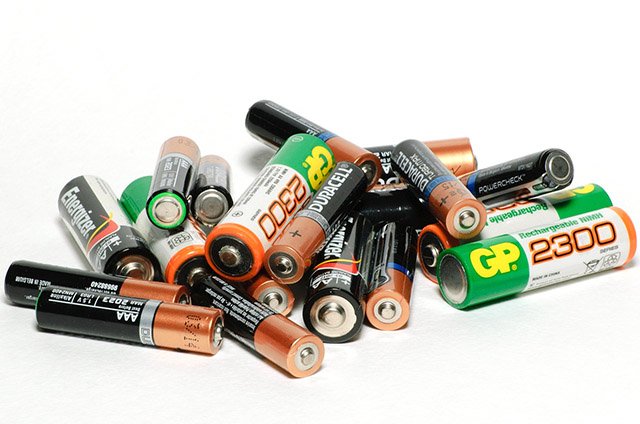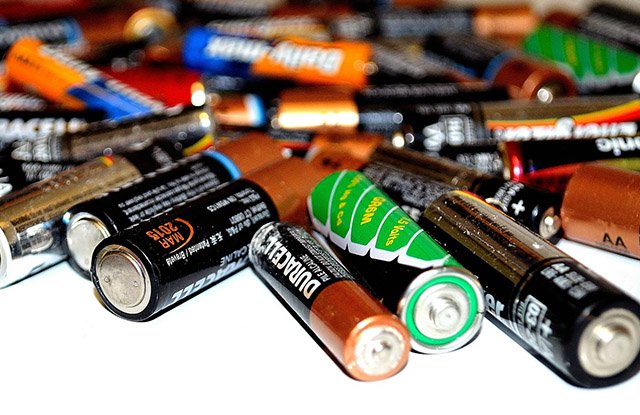
Fall back!
Sigh. Yep, it’s that time of year again. Don’t forget to turn your clocks back tonight.
I’m kind of bummed every year when Daylight Saving Time ends and all of a sudden it’s dark before we even finish dinner…but at least we gain an extra hour of sleep, right? (Ha! We all know how well that works when you’re a parent!)
Love it or hate it, the end of daylight saving time is also a good time to check the safety devices around your home that help keep your family safe. Consider this your friendly reminder to clean, test, and replace the batteries in your smoke and carbon monoxide detectors.

But what should you do with all your old batteries?
You take them to your local Call2Recycle drop-off location, that’s what!
Batteries power almost everything in our lives, from our cell phones and laptops, to noisy toys (thanks Grandma!) and smoke detectors, but as convenient as batteries are, they also have a downside. Depending on the type of battery, they can release potentially hazardous materials into the environment if not disposed of properly. Lithium batteries in the landfill can cause fires or even explode. Recycling batteries protects our environment and helps conserve our natural resources.

Call2Recycle accepts all rechargeable batteries weighing up to 5 kg each, including Nickel Cadmium (Ni-Cd), Nickel Metal Hydride (Ni-MH), Lithium Ion (Li-Ion), Nickel Zinc (Ni-Zn) and Small Sealed Lead Acid (SSLA/Pb), as well as single use alkaline, lithium primary and carbon-zinc batteries.
Since 1997, the program has recycled more than 18 million kilograms of batteries, keeping them out of local landfills and recovering the valuable materials inside them that can be used to create new batteries and other products. With 8,000 locations across the country, over 90% of Canadians live within 15 km of a Call2Recycle drop-off location so there’s no excuse. It’s easy, and it’s FREE!
5 Tips for Safe and Easy Battery Recycling
- Safety first! Be sure to safely prep your batteries. There are two options: bag or tape.
- Option A: Bag each battery in its own clear plastic bag before placing it in a storage container.
- Option B: Or, tape the terminals with clear packing, non-conductive electrical or duct tape, keeping label visible.
- Stay cool. Store the batteries in a cool, dry place. Incidents can occur when batteries are exposed to inclement or excessively hot weather. Store them in a plastic container; avoid metal.
- Possible damage? If you see a swollen or bulging battery, immediately put it in a non-flammable material, such as sand or kitty litter in a cool, dry place. DO NOT THROW AWAY. Contact Call2Recycle, the manufacturer or retailer immediately for instructions, especially if the label says it is Lithium or Lithium-Ion.
- Timing is everything. Aim to drop off batteries to recycle within six months, ensuring they are bagged or taped. You can use the Call2Recycle locator to find the nearest drop-off site.
- Spread the word. As we all use batteries to power our world, share the knowledge about battery recycling. It’s the right thing to do and helps keep batteries out of landfills!
Win a $100 Gift Card to Best Buy

One of my readers will win a $100 gift card to Best Buy, a Call2Recycle partner retailer, to pick up something nice as a reward for being nice to the environment! Enter in the giveaway widget below. This giveaway is open to residents of Canada, 18+. All the winner’s entries will be verified.
Click here to check out my other open giveaways and be sure to follow me on Facebook!
This is a sponsored conversation. Nevertheless, all opinions expressed are completely honest and my own. Your experience may differ.









we drop them off at the recycle depot, rona or Home Depot to recycle them
We add them to a glass jar and then my hubby brings them to Best Buy for drop-off.
We have a little basket in our desk where we collect them. Then we can dispose of them properly.
My workplace has a battery drop off area. I bring all my batteries to work and drop them off so they can be safely disposed of. It is super handy
I have a bag that is specifically for batteries…then when we go to recycle it’s all ready
We keep a box in the kitchen for the family to drop in their used batteries.
We have a jar where all dead batteries go. Even the kids know they go there. When the jar is full we take it to recycling.
We collect our old batteries in a bucket in the garage and when it’s full we take it to a recycling depot.
We save our batteries and then take them to a recycling box at the local store that has one.
We take them to the local library which is nearby.
We do not throw batteries we take them to Recycles Station we have in our city!